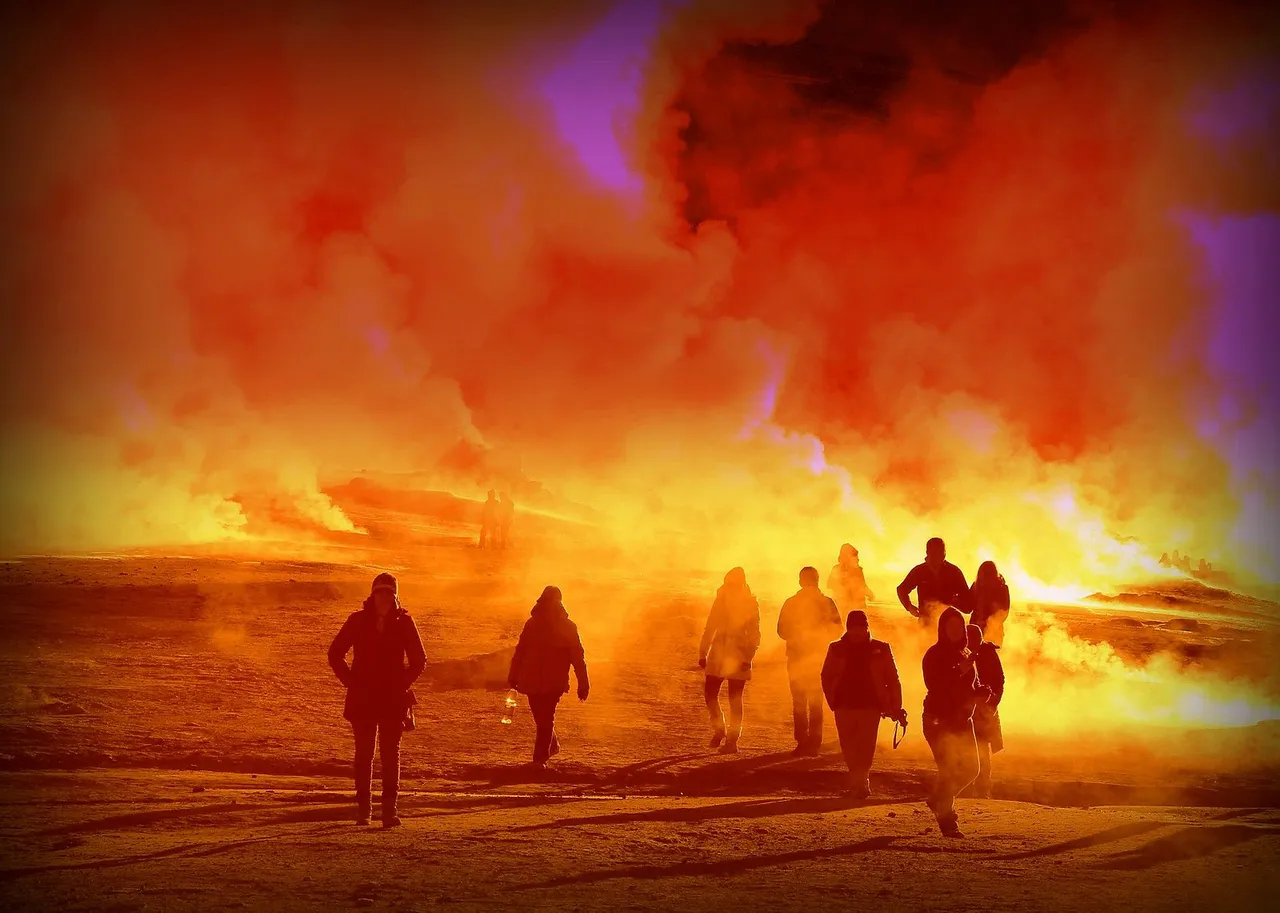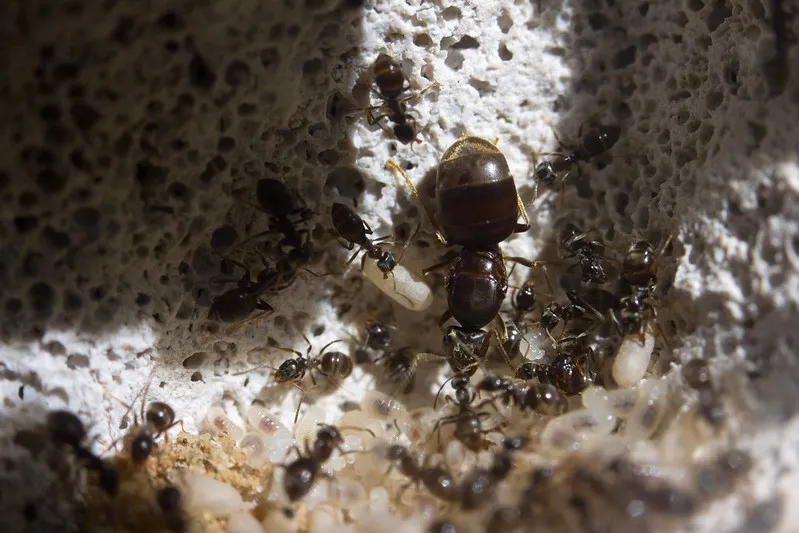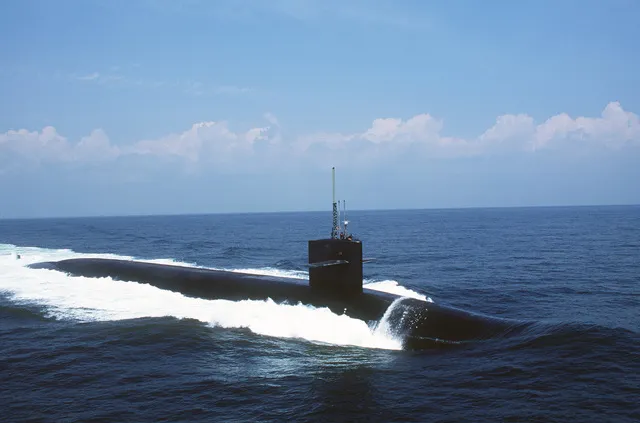Read Part 1 Here
Read Part 2 Here
Read Part 3 Here
Read part 4 Here
Read Part 5 Here
Read Part 6 Here
Survivors!

After the initial blast from the sun on the first day of the harvest, a passenger jet with sixty-three people on board managed to miss the Andes Mountains and crash land in a remote area of the Atacama Desert. The ten survivors of the crash stayed with the plane during the three days of darkness. They remained an additional few days, enduring almost continuous earthquakes until after a bit of sunlight began to filter through the haze.
The small group had been holding out hope for rescue, but the smell of the bodies around them was becoming unbearable. When they had neither seen nor heard any search aircraft and the food on the plane had been exhausted, and they only had a couple of days worth of water remaining, they began hiking West through the desert toward the coast to look for help.
They finally arrived at an empty village that had once been located between the desert and the ocean. Now the small town seemed to be nestled in the middle of nowhere, surrounded by nothing but sand. The area was naturally desolate anyway, and all available food sources had already been hauled away by ants. This region was too dry for the large ants to survive there for long, so they had taken whatever they could find and moved on.
This group of survivors had never seen the ants, and they had no idea what had happened to the world. All they knew was that the small village was abandoned. But it was evident that there had been some sort of struggle for survival here as homes, automobiles, and other structures were damaged, most of them beyond easy repair.
Of course, there were some indications of what had happened, but the group could not discern what the clues meant. They found bloodstains in a bus sitting on the side of the main road, but there were no bodies to be found. Many windows were broken, and one side of the bus had been ripped open as if by a large prying tool, something that would be too big for a person to use, perhaps an industrial machine of some type.
The ants had carried away their own dead, but an ant leg with bullet holes in it was found next to what had served as a police station. Someone also found an ant antenna draped across a roof. But though everyone looked the objects over, and they appeared to be from some kind of creature, they could not be sure of what they were looking at or what it meant.

After the third day of darkness was over and the sun began to give its light again, the food supply being hauled to the nests and the great queens by worker ants began to slow ever so slightly. The internal egg-producing processes inside the phase three queens began to slow down and, in time, would eventually stop. The build-up of great ant armies for the harvest had taken months, and each queen had produced millions of eggs. Now, in just a few more days, the harvest would continuously slow down and eventually come to an end.
Days after the harvest climax, the larger ants leading the army were already running out of food for themselves and were weakening. Yet, incredibly, due to the hypermetabolism during the harvest cycle, the ants had effectively cleansed the earth of millions of animal bodies. Most of these animals would not have survived the disastrous blasts of energy from the sun, the earthquakes, the tsunami waves, and the weather extremes that occurred during the harvest anyway.
In addition, the ants had cleared the land of plants that would have dried up and created enormous wildfires or would have been saturated with seawater and have died and rotted in place. The ants had, in fact, performed an excellent service!
As the work of the ants was almost finished, the survivors in some places could begin to emerge, and the earth's foliage could start to return bloom and bear fruit once again.
Many people and animals that had fled into the swampy regions of the earth ahead of the ants survived the initial onslaught, aided in no small part by the alligators and crocodiles that made the swamps their homes. It turns out that these great reptilians are immune to ant stings. In their water habitat, they could easily overcome even the largest ant intruders, rolling them under the water and snapping their limbs like twigs.
Sometimes herds of deer and other mammals walked right past furious battles between ants and these Crocodiles without being molested by either side. But the swamps invited another danger. The giant tsunamis came far inland and inundated most of these low-lying areas killing the majority of those seeking refuge there. But there are always survivors. The floods came and receded and then came again and again. But some of the refuge-seeking creatures always found a way to survive. The swamps had become an especially good refuge for the birds of the world as they could always find someplace dry to rest until the floodwaters receded. The wildlife that generally made the swamps their home, like the gators and the crocs, was largely only inconvenienced by the floods.
Other animals and people escaped into the frozen regions of the earth to escape the ants. But these too found survival was not just about getting away from the ants. They also had to survive the frigid temperatures and raging storms. And, of course, they did not get away from the earthquakes, volcanoes, and other natural disasters that were also taking place in these regions of cold climates just as they were in the other areas of the world.
Food was also a massive problem for those that had escaped to colder climates. There were no truces between species here at all, it was simply a dog-eat-dog survival of the fittest situation, and both the small and great fought over shelter and available resources. Often, whoever lost the fight became the very resource that then had to be defended.

A Nigerian man who made his living by creating works of art out of discarded plastic bottles and selling them to tourists survived the harvest and saved many in his Country. When the attack started, the artist known as bottle man around the village looked outside to see an elder battling a giant ant. A woman and some younger men showed up with kitchen knives, sticks, and rocks to drive the ant away but were being overpowered. Finally, a neighbor with a machete lopped the ants head off to end the fight, but what they didn't know at the time was that this was just a scout ant. The worst was yet to come.
Bottle man turned to look around among his belongings for something that would serve as a weapon, but all he had was the small knives and scissors he used to create his art. Thinking fast, he started cutting his large pile of empty bottles into strips and forming them around his legs, body, and arms. After thinking about it, he also added a section around his neck. He left plenty of room to move his head around in every direction. Looking out a window, he could see the dead ant's body lying in the street. There were also several people, but they were all preoccupied watching herds of animals stampeding past the outskirts of the town.
Moving over to the lifeless ant, bottle man scooped up some of the sticky residue oozing out of the wound where the ant's head should have been, and he began rubbing it over the sections of plastic bottles on his arms and legs. Next, he started looking around for the head, which he found where it had been left in the weeds after some of the older kids had used it as a makeshift football.
Carefully, bottle man picked up the head and went back to his home to find some cordage. There he tied the head around his shoulders to sit on him like a small backpack. The antenna would flop over his head and shoulders whenever he stooped over, making him look almost like any other ant.
Just as bottle man came back outside to show everyone what he had done, the first wave of soldier ants arrived. People scattered in every direction as panic instantly took hold, and in their haste to escape the oncoming ants, the villagers had left a small child sitting in the middle of the street crying. Bottle man ran to her and covered her with his body. Then, miraculously, the entire ant army swept past them without even stopping.
But there were ants everywhere ransacking the village. Bottle man calmed the child down with soothing words as he held a finger up to his lips for her to be quiet. When he saw that she understood, he lifted the little girl and carried her to his place. He then immediately started fitting strips of bottles around her tiny body. It was fast work, and in no time, they were outside again beside the dead ant's body, smearing the sticky ant juice all over the girl.
There was not another ant head available, and if there had been, it would have been too big for her petite frame, so this would just have to be enough. Bottle man had also picked up a small plastic bucket with a lid and wire handle, which he filled with the last oozing ant juice.
The two began to travel, looking for other survivors as they made their way out of the village. Along the road, they were passed several times by ants. Some even came over in front of bottle man and felt the dead ant's antennas. Each time the girl would get under bottle man, and he would stoop over so that the antennas flopped over his shoulders, and after a brief inspection, the ants always moved on without hurting them.
When the harvest was over, few remained among the living in what had once been the Country of Nigeria. However, many who did survive owed their lives to bottle man and the child known everywhere as Mira, the miracle girl. Because every time they found someone alive, bottle man and Mira showed them how to avoid being eaten by ants.
Once the harvest had ended, those who survived began to rebuild their lives. Even though they had all suffered tremendous losses, they still had reason to rejoice. Because now, people everywhere were free from oppression, the kind of free like they had never known before. The daily hustle was over, the corruption had ended, love abounded in this new world. The very humble person once known as bottle man was now known as "Egharevba," and he preached a message of peace and cooperation that would resonate throughout Africa for generations to come.

Governments and thought leaders from all over the world had almost completely failed in their attempt to save civilization. In some cases, like the vast stores of underground food supplies, they had actually aided the ant armies in the great harvest. However, despite this poor showing from those who thought themselves to be smarter than the average person, it was mostly those very same average people and those who might be called lucky or blessed that ended up surviving the harvest. At the same time, the brain trust of the world mostly perished.
The exception to this was found in a collection of students at Belarus State University. These students had all attended classes held by the late Professor Ivan Savitskaya, an amateur geologist whose hobby was hunting for fossils and unusual rock formations. Professor Savitskaya was teaching modern computer technology at the University, but each year he ended his class with a field trip for those who volunteered. These volunteer students would travel with him to an area riddled with caves to see something that he had discovered during one of his personal expeditions.
Inside a small cave, the Professor showed the students a fossil of a giant ant surrounded by unhatched eggs, which were also very large for an ant. He then went on to tell the students that the fossil only dated back a few thousand years. He proved this by showing an item hidden from all but the Professor's trained eyes. Imbedded just under the ant's body was a petrified human bone. Rubbing a small section at one end of the barely identifiable bone, the Professor revealed to them a small rounded section of what appeared to be gold.
It was a small part of maybe a gold wrist bracelet that had been worn by the owner of that petrified arm. The rest of the bracelet was completely embedded in the rock of the cave wall. By showing this to you, he said, I'm trusting each of you to leave this important find as it is and not reveal this discovery to those who might come seeking treasure. This place, he said, is probably a remnant of what is known as the great flood. But, I believe he continued, the world was not only dealing with a flood but also by an invasion of these ants. This one, he said, pointing toward the fossil, probably got trapped by a big wave and covered with mud and debris.
Giant ants have been discovered in other regions among fossils and in places where they should not have been, and those researchers have simply overlooked or completely downplayed this fact, said the Professor. This is just a tiny part of the available evidence that leads me to believe that there was a great cataclysm at some point in the past, Maybe only a few thousand years ago, opined the Professor. The DNA records even show a significant bottleneck in human population growth a few thousand years ago. This matches my own personal theory that these disasters are cyclical and that one day soon, we may have to face something like this again.
Professor Savitskaya explained that if he was correct, such disasters are accompanied by an invasion of ants, whether terrestrial or extraterrestrial ants, he could not tell for sure. Still, his guess was that they were a special breed of ants from this world, perhaps living deep within the earth even now. I have tried to be prepared for a major disaster all of my life, said the Professor. I'm showing you this now because I'm not getting any younger, and I want someone else to know these things and be ready for that day if it does come.

Taking Professor Savitskaya's advice to heart, his students, over time, had formed a club that met once a year to discuss preparation for a disaster and a potential war against an ant invasion. And though the Professor himself had passed away almost a decade ago, his former students were still preparing for what later, after the event, would become known as the great harvest.
When the power went off in Belarus, and the sun went dark, each member of the apocalypse club immediately went to work. First, they grabbed all of their family and friends that were close at hand, then they went straight to the University with the emergency supplies that had been pre-staged in trailers, trucks, and cargo vans for the potential arrival of this day. They had all studied ant behavior and planned ways to defend against ant attacks through extensive experimentation in the field.
They had battery-powered sound generators inside faraday cages and both short and medium-range radios for communication. They had barrels of every known ant poison or deterrent available to build a perimeter around the University. They also had enough food and water stored to last for at least three months. Hopefully, the disaster would not last that long, but they would be ready if it did.
After some tedious trials, they had discovered the sound frequency that ants used to communicate with each other, so special loudspeakers were attached to the roofs of all the campus buildings and connected to the battery-powered sound generators. They hoped to keep any ants driven far away from that entire area using these nonlethal sound-producing devices. Still, if any ants did come closer, the next line of defense was the poisons, and after that, there were rings of diatomaceous earth surrounding the buildings.
If the diatomaceous earth failed, then the following line of defense was noxious smoke-producing candles. Then, if all else failed, the final defensive measure was provided by homemade flame throwers, but everyone prayed that these would not be needed because of the danger of setting the entire campus on fire.

Out of all the military ships and submarines at sea when the day of harvest began, only the USS Pennsylvania (SSBN 735) survived the catastrophic changes happening above them to both the landmasses and the oceans. Nothing was in its place. There was no good way to navigate in a world that had utterly rearranged itself in only a matter of days. The ocean's depth had been vastly reduced, and there was dry land now that had been deep underwater only days ago.
The Submarine's Captain did not yet understand that the land he was viewing through his periscope had also undergone massive changes. Entire mountain ranges had simply disappeared. The land was flatter now, the oceans smaller and not nearly as deep. There were no longer any ports to return to. There was no radio traffic with orders from command centers. Those institutions no longer existed, and those who had manned the military bases had become food for a different type of military force, one that had not been planned for. So this lone surviving nuclear-powered submarine finally surfaced after several days underwater without contact with the outside world.
They had heard no shipping sounds anywhere, and they had been pummeled by venting underwater volcanoes, huge waves, and the almost continuous roar and high-pitched grinding sounds that accompanied large movements of landmasses. Once surfaced, they searched the coastlines for signs of life, but they saw only an occasional bird. Since nothing was familiar, they could not fix their location.
When it became apparent that none of the coastlines they were viewing existed on their charts, they started creating new maps of the coastlines encountered as they went. The radio room broadcast over various radio frequencies but never received any answers. Even with the sophisticated eavesdropping equipment onboard continuously scanning for any human electronic activity, the massive communications systems they had come to take for granted seemed to have simply vanished.
After six months at sea and running aground twice in these uncharted waters, a signal was finally received. It was from a land-based unit estimated to be about one hundred and fifty miles north of their current location. The voice on the radio spoke Russian. They discovered that it was emanating from a building in what was formerly Belarus. All indications were that these were the last people on earth. That was not really true, but these were the last people on earth that retained the possibility to contact a Submarine by radio, and they were the last people still living in a modern city.
There were one hundred and thirty-five men and two women on the USS Pennsylvania. And, after a few days of assurances about their peaceful intent, they were finally greeted by a contingent from the surviving students, staff, and citizens of Belarus that had just made the arduous journey to the coast in a post-apocalyptic world.
The saved libraries and most of the buildings and infrastructure of the University, coupled with the power generated by Pennsylvania's nuclear reactor, once power connections could be established, were more than enough to begin rebuilding civilization. This nuclear power plant would last for at least twenty years. By then, new power generation plants hopefully could be built. This would then become the beginning of the New World.
This new world would form a language of its own which would blend Russian and English into a new tongue. The original area around the University would remain Belarus, and after a lengthy discussion, it was agreed that their new world would be called Pennsylvania.
Only a few weeks after the sun began to shine its light again on the new world, the last of the giant ants died away and would not return again until the next harvest. For a while, ants would become the most hated creatures on earth and were trampled down by animals and birds alike. Nests were destroyed wherever found, but of course, the ant is very resilient, and they continued their tiny little lives knowing that their day would come again and they could wait.
Over time, the beasts of the earth began to forget about the ants, and they again started to ignore them and their constant activity. By the time of the next harvest, all would be forgotten. Only myths, rumors, and conspiracy theories would remain.
This concludes the 7 part story of The Great Harvest, if you enjoyed this story and would like for me to continue writing such adventures please let me know in the comments below.
